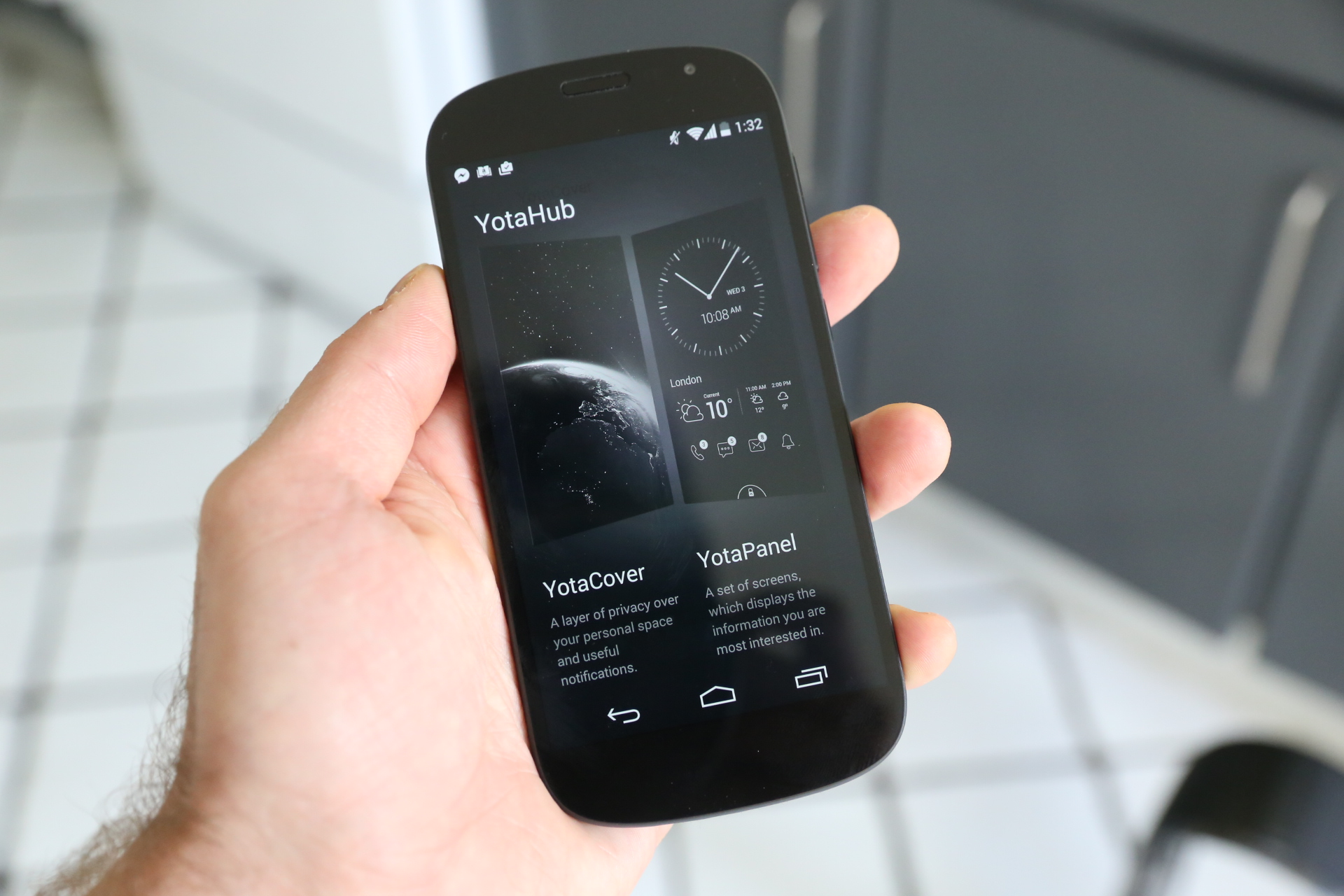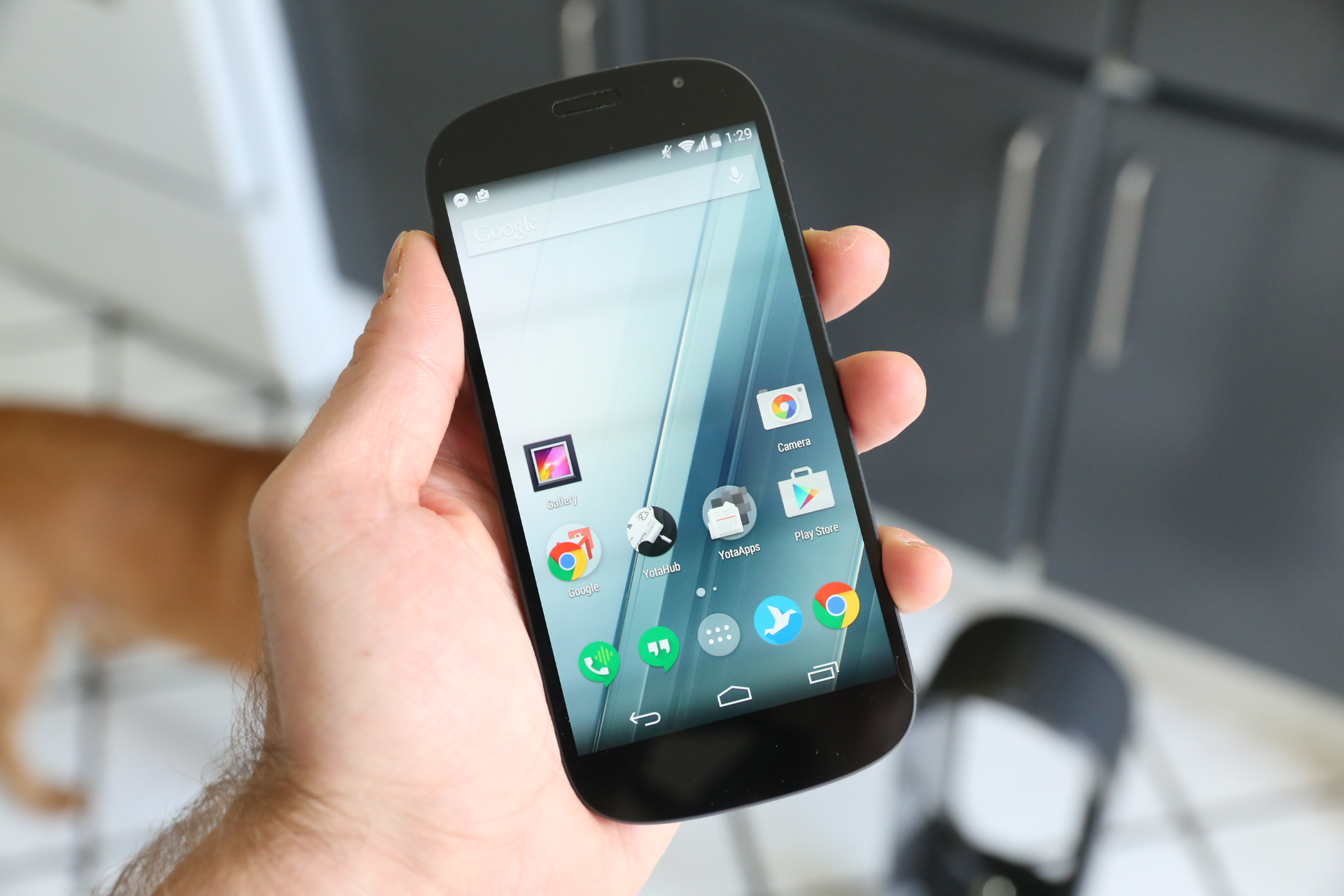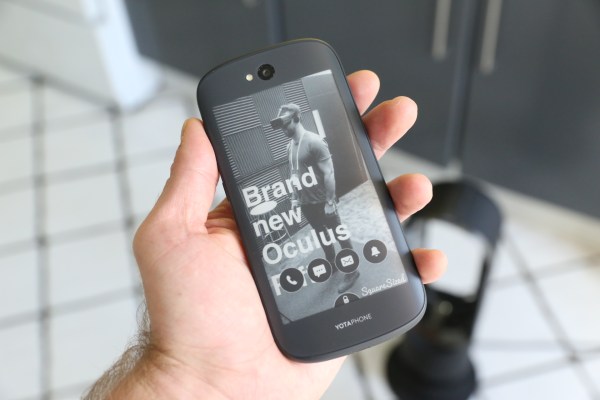Yota Devices is a Russian company that entered the mental space of tech enthusiasts everywhere with the debut of the original YotaPhone a couple of years ago. In 2014, it launched the YotaPhone 2, a second-generation smartphone that greatly improved on the original concept. The YotaPhone 2 is a surprisingly capable, well-equipped Android smartphone – which happens to also have the clever addition of a second, fully touch-sensitive e-ink display, all wrapped up in a very smartly-designed package.
Video Review
Basics
- 5-inch, 1920×1080 OLED primary display
- 4.7-inch, 960×540 E-ink secondary display
- 2.3GHz quad-core process
- 2GB RAM, 32GB storage
- 8MP rear, 2MP front camera
- MSRP: Roughly $850 USD unlocked
- Product info page
Pros
- Secondary screen is incredibly useful
- Physical design is great
Cons
- E-ink screen contrast/refresh could be better
- Still no official U.S. launch date
Design
The YotaPhone 2 is an amazing example of massive improvement through just one generation of iteration: The original device was a mess of compromises, generally unfit for use beyond an R&D lab. The YotaPhone 2, however, is not just a good execution of a dual-screen smartphone – it’s also a well-designed smartphone no matter how you look at it, which understated, but pleasing looks and a curved case with a nice weight that just always feels awesome to hold.
[gallery ids="1107402,1107397,1107399,1107406,1107405,1107400,1107396,1107404"]
Yota’s latest is reminiscent of the Palm Pre, in a very good way. It’s thicker than a lot of current top-tier smartphones, which is no doubt due to the fact that it carries an entire, 4.7-inch secondary display on its reverse side, but that doesn’t take away from its ergonomically positive qualities. The added heft and weight make it feel like a much more comfortable handful than many current-day devices, which can tend to feel cheap or less than substantial, especially when they use plastic as their primary case material.
The matte finish of the back of the YotaPhone 2, which is designed to give you a glare-free, easy-to-read surface through which to present the E-ink screen, is also nice to look at even when the screen is showing nothing but black. If there’s a downside to the finish, it might be that the smartphone ends up having a certain slipperiness, but overall the effect is one of polish and attention to detail that again, is shocking considering the first-generation YotaPhone, and that helps the YotaPhone 2 stand apart (in a good way) from other Android devices, even leaving aside that secondary display.
Features
YotaPhone 2’s signature feature is the one that stares you right in the face: The E-ink display on the phone’s backside, occupying a place normally reserved for something as banal as a manufacturer name, or even worse, carrier branding. The 4.7-inch screen covers a big chunk of the back of the phone, with bezels around each edge filling out the remaining space, and offers up dynamic content based on your phone’s settings.
You can set the YotaPhone 2 to display an image or series of images, from either your local library, social sources like Instagram or Facebook, or other galleries. It can also show you notifications, including missed phone calls, messages, mail and “other.” Out of the box, third-party apps can’t push full notifications to the e-ink screen, but they can at least let it know something came in, so you can know when you have to activate the primary screen to check them out. Yota also offers an API that lets developers display notifications from their app natively, and it’s great when they take advantage of that.

The E-ink screen can also fully mirror your Android OS, giving you access to apps like Kindle that make perfect sense on the black and white, non-backlit display. Maps is another good use, giving you enough information to guide your walk around an unfamiliar city while conserving precious battery life. The Selfie app also lets you use the 8 megapixel, higher quality rear camera to snap self-indulgent pics, and gives you a minimal but ultimately very effective view of what you’ll get in low-res black and white while doing so.
You can also set the screen to provide access to a selection of apps, news headlines, weather information, a real-time clock and more – Yota offers a lot of customization options for its so-caled YotaPanel, so you can really get creative. Ultimately the E-ink display has surprisingly few limitations in terms of what it can and can’t show, and that’s a key selling point; the original phone was pretty limited in this regard, and it really detracted from that phone’s overall value. The YotaPhone 2’s screen is, by contrast, a Swiss Army knife that you might eventually have trouble living without.
Performance
The YotaPhone 2 benefits from offering a version of Android that’s essentially stock – albeit a little behind the pace of pure Nexus releases. It’s currently running 4.4.2, but Yota has promised an update to Lollipop eventually. Even without 5.0, you’ll get a version of Google’s mobile OS that’s solid, and that works well on the top-notch processor and hardware Yota has provided with this smart device.
When running my standard complement of apps, games and utilities, I encountered no performance surprises or issues with the YotaPhone 2. The device matched my battery usage on an average device when used in the normal way, i.e. without really employing the E-ink screen for much. That means it managed about a day of use. But gradually I learned to lean more heavily on the E-ink screen, and my average usage stretched out to about three days, which includes ample active reading time via the Kindle app.
In some regards, like the camera, the YotaPhone 2 comes across as more of a mid-level device, but the fact that you can essentially use the rear-facing shooter as a dedicated selfie-cam makes up for that camera itself offering only adequate overall performance compared to the general Android smartphone population. It suffers especially in low-light, so if you’re a huge mobile photography buff, you probably want to move right along.
Display

The screens on the YotaPhone 2 are both pretty excellent. The new 5-inch display has excellent pixel density, and the AMOLED’s show great blacks and excellent colors. It’s a little finicky when it comes to auto-brightness and ambient light detection, but that’s not a huge deal, and it’s something that still afflicts smartphone from even the most respected Android OEMs.
The E-ink display is a big improvement form the one on the original YotaPhone, but the 960×540 resolution certainly isn’t going to wow anyone in terms of crispness of text or image. Even so, it’s about on par with Kindles beyond the top-tier Voyage launched this year. Contrast and refresh rates also aren’t pushing any boundaries, but these are not what users need in an e-ink display. The key ingredients, which include basic legibility, size and full touch capabilities are all here, and the result is an extremely functional display that offers a good reading experience even across multi-hour sessions.
Bottom Line
The YotaPhone 2 is a huge improvement on the original YotaPhone, so much so that this device transcends the niche appeal of its predecessor. That said, it’s still a smartphone that’s unique enough to really strike a chord with a smaller audience – those that enjoy reading a lot, and don’t want to carry a Kindle, for instance, or anyone who has to do a lot of document review on the go. But the execution here gets much closer to proving the benefits of a secondary low-power display for just about anyone, and does a much better job of doing so than hacky tricks used by other OEMs, including cases with cutout windows that are meant to offer low-power access to notifications without waking the whole screen.
YotaPhone 2’s biggest weakness right now is honestly just consumer access – ordering one unlocked will currently cost someone based in the U.S. around $850 new, which is a big ask for any device, let alone one from a relatively unknown company. Still, it’s one of the first smartphones in a long time to genuinely surprise me, and if it can secure a U.S. launch date and reasonable pricing soon, as YotaPhone has said it should, it will be a great contender for Android fans looking for something both functional and unique.
